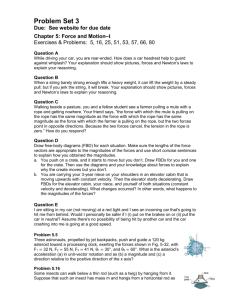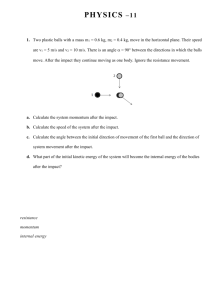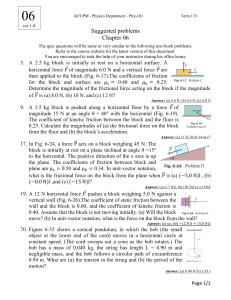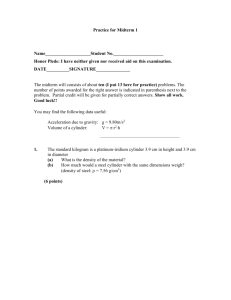Physics 513 Name Vaughan Worksheet Newton`s Second Law
advertisement
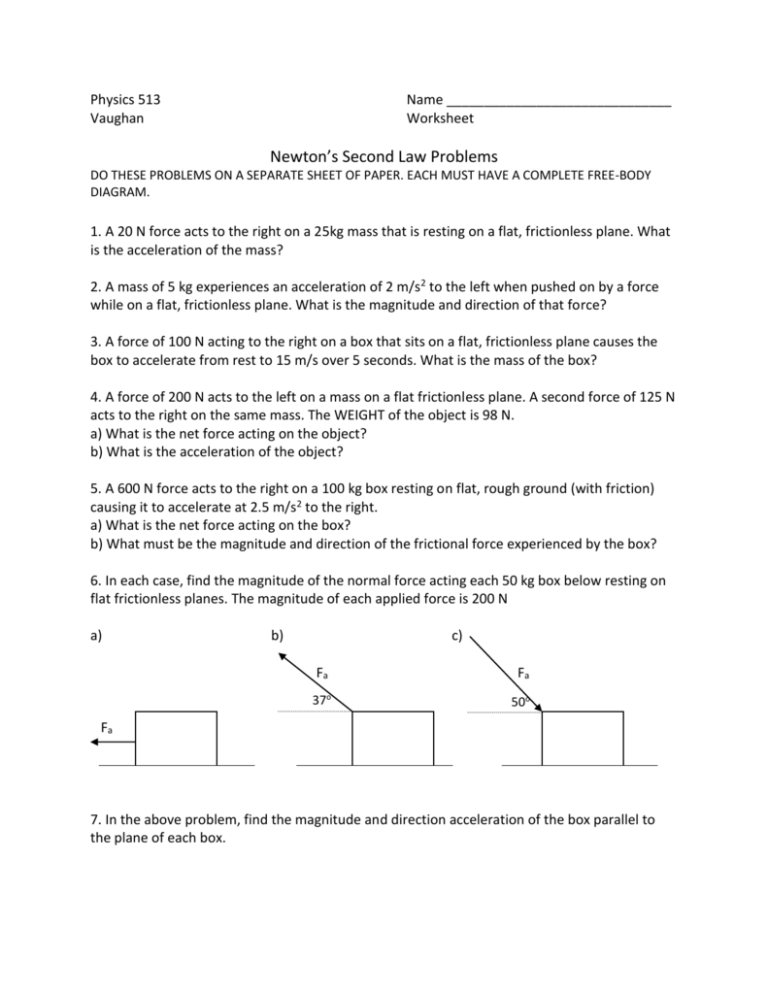
Physics 513 Vaughan Name ______________________________ Worksheet Newton’s Second Law Problems DO THESE PROBLEMS ON A SEPARATE SHEET OF PAPER. EACH MUST HAVE A COMPLETE FREE-BODY DIAGRAM. 1. A 20 N force acts to the right on a 25kg mass that is resting on a flat, frictionless plane. What is the acceleration of the mass? 2. A mass of 5 kg experiences an acceleration of 2 m/s2 to the left when pushed on by a force while on a flat, frictionless plane. What is the magnitude and direction of that force? 3. A force of 100 N acting to the right on a box that sits on a flat, frictionless plane causes the box to accelerate from rest to 15 m/s over 5 seconds. What is the mass of the box? 4. A force of 200 N acts to the left on a mass on a flat frictionless plane. A second force of 125 N acts to the right on the same mass. The WEIGHT of the object is 98 N. a) What is the net force acting on the object? b) What is the acceleration of the object? 5. A 600 N force acts to the right on a 100 kg box resting on flat, rough ground (with friction) causing it to accelerate at 2.5 m/s2 to the right. a) What is the net force acting on the box? b) What must be the magnitude and direction of the frictional force experienced by the box? 6. In each case, find the magnitude of the normal force acting each 50 kg box below resting on flat frictionless planes. The magnitude of each applied force is 200 N a) b) c) Fa Fa 37o 50o Fa 7. In the above problem, find the magnitude and direction acceleration of the box parallel to the plane of each box. 8. Sam, 80 kg, and Larry, 60 kg, are standing face to face while on a smooth sheet of ice. Sam pushes Larry with a 300 N force to the left. a) What is the magnitude and direction of Larry’s resulting acceleration? b) What is the magnitude and direction of Sam’s resulting acceleration? 9. Betty, 65 kg, gets on an elevator at the 54th floor and descends to the 12th floor. Being that she works for the IBWM (International Bureau of Weights and Measures), there is a scale on the elevator that reads in Newtons. Initially, the elevator is at rest. It speeds up downwards at a rate of 3 m/s2, achieves a constant speed and then slows down at 1 m/s2 while going downward to come to rest. a) What is the reading on the scale right when she gets on the elevator but before it moves? b) What is the reading on the scale right when it just begins to descend? c) What is the reading on the scale right when it achieves the constant speed? d) What is the reading on the scale right when she is slowing down? 10. You are an elevator safety inspector. You go to inspect an elevator that has a maximum rate of acceleration of 2 m/s2. The maximum tension that the cable can withstand without breaking is 12,000 N. The mass of the elevator is 400 kg. Assuming the average mass of human being is 70 kg, what is the maximum number of people that can safely ride this elevator without the cable snapping? 11. A rocket has a mass of 20,000 kg. It launches from rest. Assuming the rocket travels straight upward, once it reaches a height of 1 km, it has a speed of 300 m/s. a) What was the magnitude and direction of the acceleration of the rocket? b) What was the magnitude and direction of the thrust force that acts on the rocket? 12. A 90 kg criminal is trying to escape a prison. The problem is, he only has a rope that can bear a maximum tension of 600 N. Find the magnitude and direction of the acceleration he could have that would cause the rope not to break. 13. A 65 kg skier is at the top of a frictionless hill that has an angle of inclination of 35 degrees. The hill is 40 m long. a) Find the net force parallel to the plane b) Find the acceleration parallel to the plane c) Find the speed at the bottom of the hill d) Find the normal Force. 14. A skier (mass of 60 kg) is being pulled up the frictionless ski slope by a T-bar. The slope has an angle of 10 degrees with the horizontal. The tension in the rope is 400 N. a) What is the net force parallel to the incline? b) What is the acceleration parallel to the incline? 15. Jimmy is moving. He needs to pull his couch (120 kg) up a frictionless ramp into the back of the truck. The ramp is 5 meters long and the back of the truck is 2 meters high. a) If he pulls the couch up the incline with a force of 1000 N, does the couch go up or down the incline (note this force acts parallel to the plane)? b) What force does he need to apply to have the couch accelerate at 0.75 m/s2 up the incline? 16. Tammy is pulling Jack up a hill on a sled. Jack and the sled have a mass of 45 kg. The angle of incline is 30 degrees. The tension in the rope is 400 N. The rope makes a 20 degree angle to the incline as shown. a) Find the components of the tension that are parallel and perpendicular to the plane. b) Find the net force parallel to the plane c) Find the acceleration parallel to the plane d) Find the normal force. 17. A 5 kg mass is placed at rest on a flat surface that has a coefficient of static friction of 0.3 and a coefficient of kinetic friction of 0.2. a) What is the greatest magnitude of force that can be applied horizontally before the mass begins to move? b) If I apply a force of 10 N to the right on the mass, does it move? If yes, find the acceleration. If no, find the magnitude and direction of the static frictional force. c) If I apply a force of 50 N to the left on the mass, does it move? If yes, find the acceleration. If no, find the magnitude and direction of the static frictional force. 18. A 10 kg object moves with a constant speed of 5 m/s across a flat horizontal surface as it is pushed by a 35 N force to the right. a) What is the magnitude and direction of the frictional force it is experiencing? b) What is the normal force? c) What is the coefficient of friction? 19. A blender (that has a weight of 196 N) is being pulled on a flat, horizontal surface by a rope that has a tension of 80 N pulling directly to the left. The coefficient of kinetic friction is 0.3. a) What is the net force parallel to the plane? b) What is the acceleration parallel to the plane? 20. A sled is being pulled towards the left on a flat, horizontal surface by a rope that makes a 30 degree angle with the horizontal. The mass of the sled is 40 kg, the tension in the rope is 200 N and the coefficient of kinetic friction between the ground and the sled is 0.20. a) What is the normal force? b) What is the net force in the parallel direction? c) What is the acceleration in the parallel direction? 21. A hockey puck (with a mass of 0.5 kg) is sliding across the ice with an initial velocity of 4 m/s East. It slows down and comes to rest over 100 meters. a) What is the magnitude and direction of the frictional force? b) What is the coefficient of friction? 22. Find the coefficient of kinetic friction that exists in problem 5. 23. If in 6c, there had been a coefficient of kinetic friction of 0.3, what would the acceleration have been of the mass? 24. A 25 kg box is on a plane that has a coefficient of static friction of 0.25 and a coefficient of kinetic friction of 0.15. The angle of inclination is 30 degrees. a) What would be the magnitude of the maximum static frictional force? b) What would be the magnitude of the kinetic frictional force? c) What is the magnitude of the parallel component of the weight? d) Will the block move? If it does, what will be the acceleration? 25. A toaster (mass of 5 kg) is placed on an incline that has a 25 degree angle. The coefficient of kinetic friction is 0.1. Assume the toaster moves. a) What is the normal force? b) What is the magnitude of the frictional force? c) What is the net force parallel to the plane? d) What is the acceleration parallel to the plane? 26. A 150 kg box is at the middle of a 5 meter long, 0.5 meter high ramp that has a coefficient of kinetic friction of 0.25. The box will be pushed up the ramp by an applied force acting parallel to the plane and up the plane. a) What is the normal force acting on the box? b) What is the magnitude of the kinetic frictional force that will act on the box once it moves? c) What must be the applied force such that the box moves up the ramp at a constant velocity? d) If the applied force is 450 N acting up the ramp, what is the magnitude and direction of the acceleration of the box? 27. Two ropes are tied to a 50 kg mass. The mass hangs vertically downwards. What is the tension in each of the ropes? 28. A sign is hung from two ropes. Rope 1 goes horizontally left. Rope 2 goes up and right at a 37o angle. The sign has a mass of 300 kg. What is the tension of rope 1? Rope 2? 29. A picture is hung on a wire from a nail in the wall. A) If the picture has a weight of 40 N and the angle between the two wires is 120o, what is the tension in each segment of the wire? B) If the angle were changed to 80o, find the tension in each segment? Is it larger or smaller than from A? Why does that make sense? 30. A 300 kg non-denominational holiday wreath is suspended over main street with two wires. A) If each wire makes a 30o angle to the horizontal What is the tension in each wire? B) If wire 1 made a 30o angle and wire 2 made a 45o angle, what would be the tension in each wire? 31. A 10 kg box is pushed up against a wall with an applied force. If the coefficient of static friction was 0.25, what is the minimum value for the applied force that holds the object at rest? Fapp

